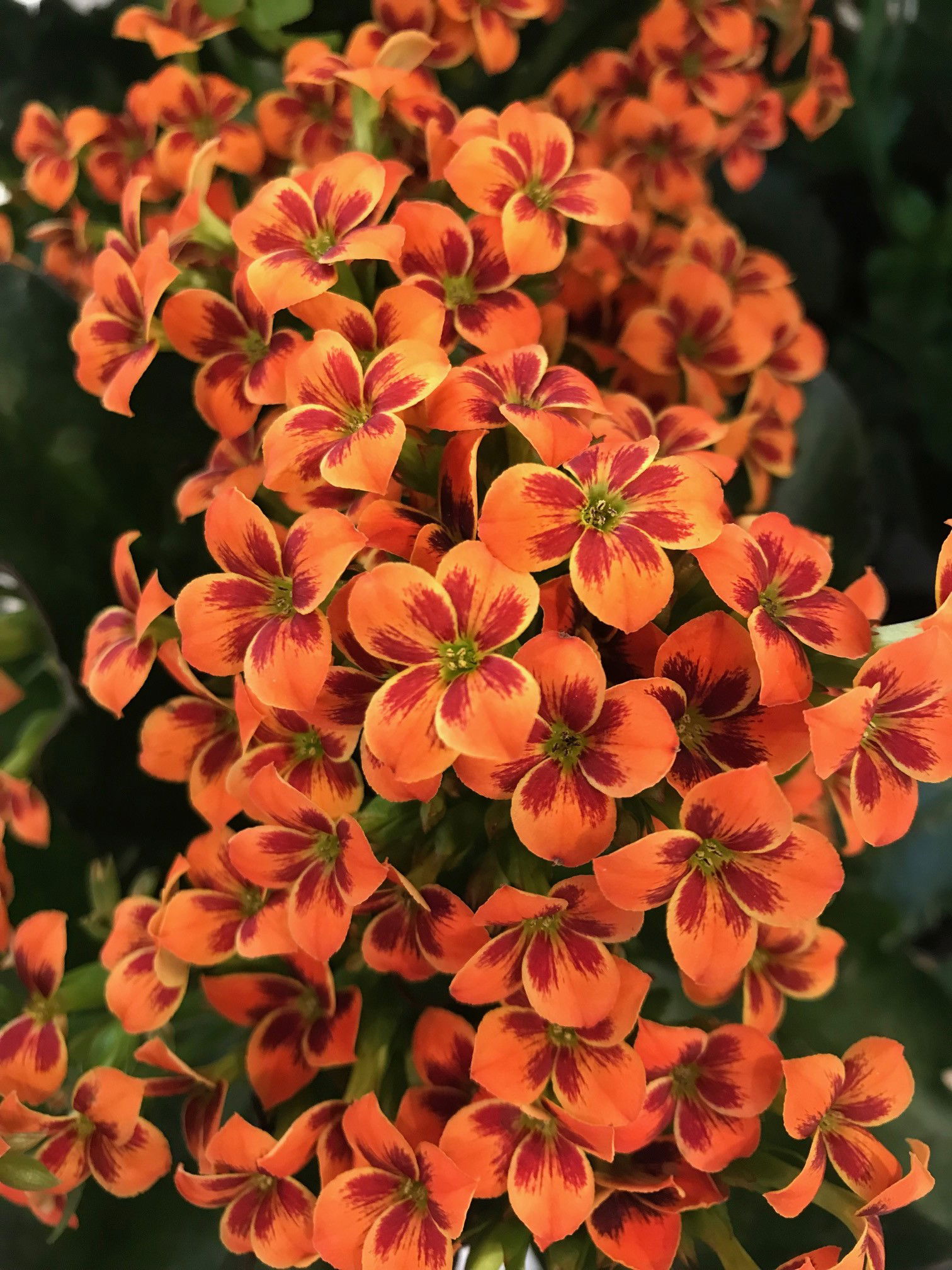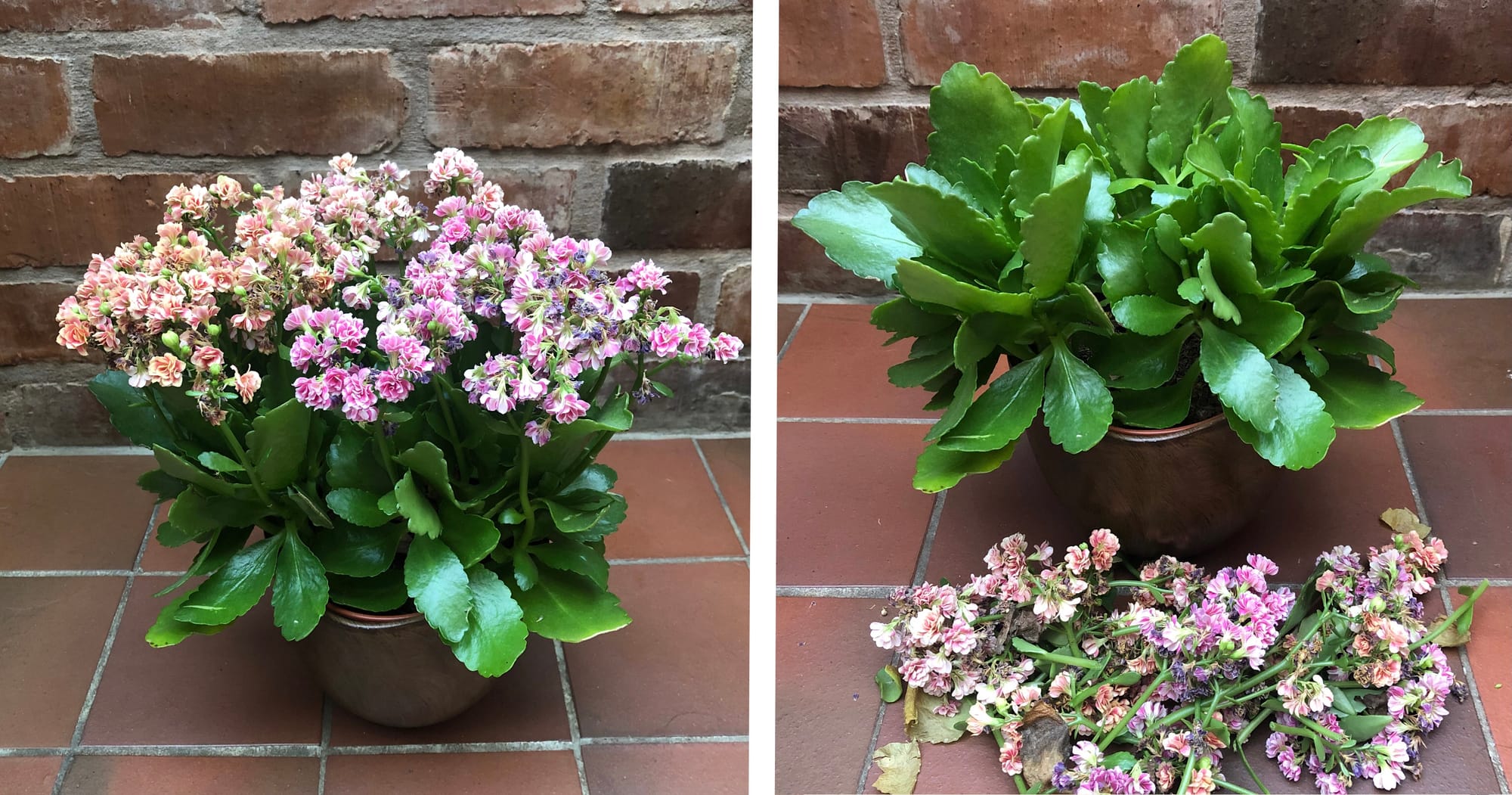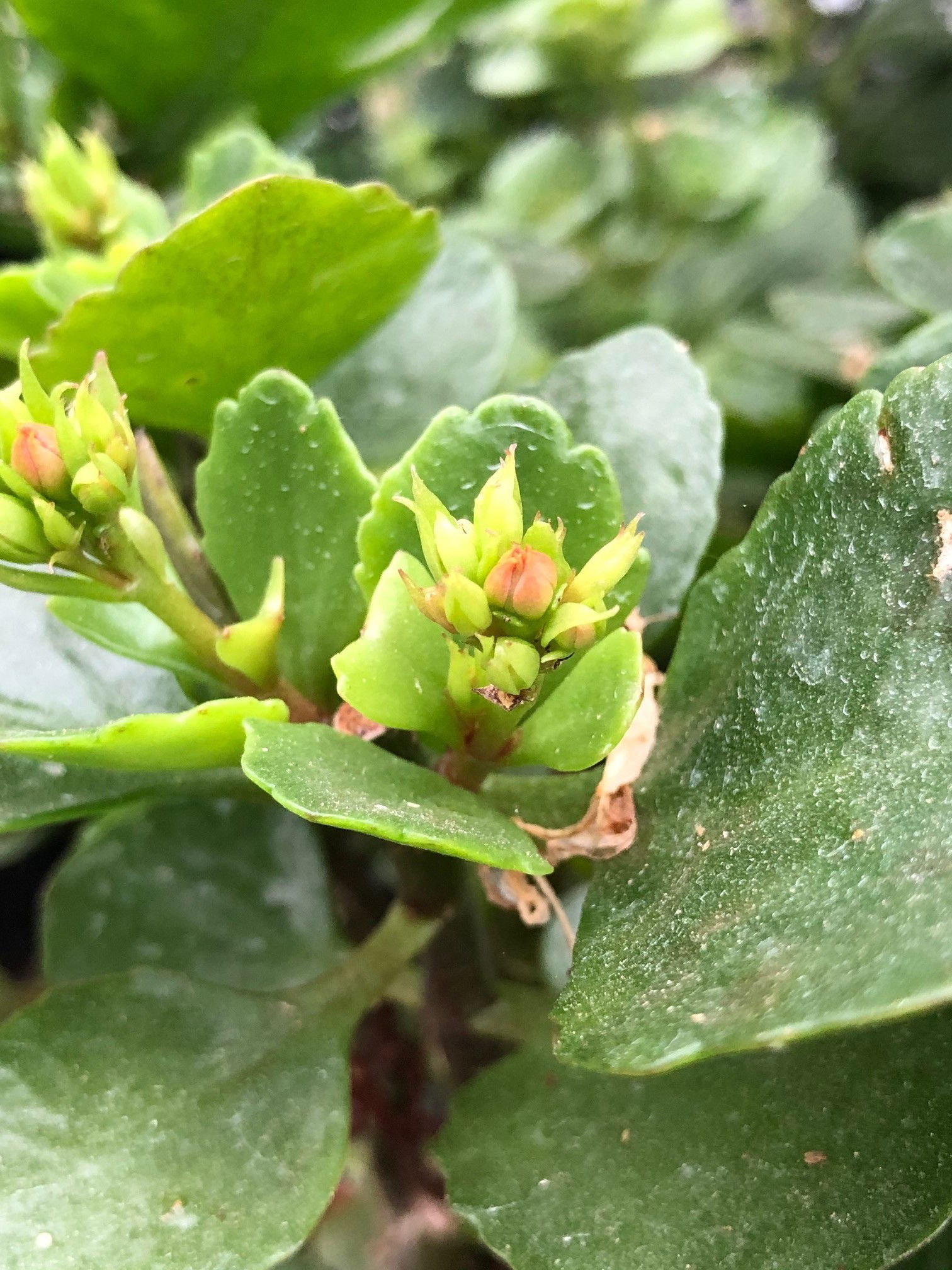
Kalanchoe blossfeldiana
Contents
- Top Tips
- Location, Water, Humidity & Fertilisation
- Dormancy Period & Annual Flowers
- Common Issues
- Origins, Temperature, Propagation, Repotting & Toxicity.
Need the answer to a specific plant query? Book a 1-to-1 video call with Joe Bagley, the website's friendly author to overcome and address your niggling problem! Available on iMessage, WhatsApp, Facebook Messenger & more.
Top Tips & Info
- Care Difficulty - Moderate
- Flaming Katies like to be situated in a bright location with the added possibility of minimal sunlight. Only expose the specimen to around an hour or two of morning sunlight to help the longevity of its flowers.
- Allow the soil's top third to dry out in between waters, reducing this slightly further in the height of winter. Over-watering is the number one issue with indoor gardeners, whereas dehydration can result in wilted/yellowed flowers.
- Fertilise every two weeks while in bloom using either a 'Houseplant' or 'Streptocarpus' labelled feed to provide higher counts of potassium. Reduce this frequency to monthly once the final flower elapses at the tail end of summer. Increase feeds back to fortnightly at the start of spring.
- Keep an eye out for Aphids that'll hide in the plant's juvenile growth.
- Scroll down to 'Common Issues' if your specimen has problems with yellowing leaves, shortly after the flowering period.
Location & Light - 🔸🔸🔸
Avoid situating your specimen in a dark location, as yellowing leaves and a poor show of blooms are common with deep shade. Instead, locate yours in an area that offers bright light, with the possibility of morning or evening sunlight. Although the risk of sun-scorch can be high with recently purchased specimens, limiting the time spent in the sun to just an hour or two is perfect for long-lasting flowers.
In terms of a location, we'd recommend either a north, east or west-facing window, a semi-shaded conservatory or around a metre from a south-facing window.
Water - 🔸
During the spring and summer, be sure to keep the specimen on the moist-side to life to avert inconsistent watering. We'd recommend allowing the top third to dry out in between waters, using your finger as a method of confirmation for drying soil. In autumn and winter, reduce the watering so that the majority dries out in between waters. Under-watering symptoms include stunted growth, crispy lower leaves, and wilting flowers - increase waters slightly and decrease the time spent in direct sun or high temperatures. We'd recommend introducing a watering-schedule to avoid future dehydration. Over-watering symptoms include yellowing leaves, stem collapse, root rot, and stunted growth. These issues are usually caused by an excess of soil moisture, too little light, saturating both the foliage & flowers, incorrect soil type, or a pool of standing water between the plastic and decorative pots. For more information about this, scroll down to 'Common Issues' to learn about more on how to address this.
Humidity -
This is not necessary; however, a quick hose down from time to time will wash away both potential pests and dust particles from the leaves. Fungal and bacterial diseases, such as Botrytis petal blight or powdery mildew, will engulf the flowers if excess moisture settles in their cubbyholes. Immediately remove the affected areas and place in a warmer room until the moisture has evaporated.
Fertilisation - 🔸🔸
While in bloom, fertilise once every two weeks using either a 'Houseplant' or 'Streptocarpus' labelled feed. Something that has a high count of potassium (N-P-K) is perfect for the regulation of its flowers and developing buds. Once the flowers have elapsed, reduce the frequency to monthly, using a 'Houseplant' labelled feed. Those in the summer can be fertilised slightly more than in the winter to fuel the development of juvenile growth.
 The beautiful inflorescences of the Kalanchoe blossfeldiana.
The beautiful inflorescences of the Kalanchoe blossfeldiana.
Dormancy Care & Annual Flowers
Flaming Katies will naturally flower in the spring or summer months. If you've purchased a specimen that's in bloom at another period of the year, it has most likely been subject to artificial conditions to stimulate a show of inflorescences.
To fulfil its dormant needs, which in turn will enhance the chance of another bloom, provide a bright, and cool autumn and winter period around 15℃ (59℉). Keep the roots pot-bound to add further stress onto the specimen, which in turn will significantly heighten the chance of flowering. Blooms will generally appear in the summer, during the active growth season.
The following steps should be taken from early autumn until the end of winter.
Sunlight & Location
Be sure to provide a bright location with little to no direct sunlight. Although the winter rays won't necessarily hurt the plant, be careful not to fall in the trap of sun-scorch and severe dehydration. Avoid deep shade and the use of artificial lighting at night or locations that boast temperatures higher than 18℃ (64℉).
Hydration
Reduce waters so that at least half of the soil becomes dry. It's essential to keep them on the drier side to life, as they'll think that hard times are ahead and therefore will need to pass its genes on to the next generation.
Occasional Feeds
During the autumn and winter, fertilisation should be performed at monthly intervals with a 'houseplant' feed. While the flowers are in development or in bloom, use a Tomato fertiliser to provide fortnightly nourishment of potassium.
Reduce Everything
This is to remind you that everything needs to be reduced - especially the temperature.
Temperature
This is the most significant step; reduce the temperature down by around 5℃ compared to the summertime or place in a room that's between 14º - 17℃ (57º - 62℉). You'll be at a significant disadvantage if the ambient temperature is kept constant throughout the year, as Flaming Katies will only respond in locations that have daily fluctuations of around 7℃. Never exceed the minimum temperature as it may lead to plant death or yellowed foliage at a bare minimum. If these steps are followed successfully, you could see a show of blooms in the following summer - but remember, dealing with nature may not always provide the results you'd relish.
 Once the blooming period is over, be sure to prune off the flower's stems to help promote more basal growths that'll develop more flowers in the following springtime.
Once the blooming period is over, be sure to prune off the flower's stems to help promote more basal growths that'll develop more flowers in the following springtime.
Common Issues with Flaming Katies
Root rot is a common issue among specimens sat in too dark environments with prolonged soil moisture. Symptoms include rapidly yellowing leaves, mouldy soil, stunted growth and a rotten brown base. Take the plant out of the pot and inspect health below the compost line. If the roots sport a yellow tinge, you're good to go, but those that are brown and mushy must be addressed immediately. More information about managing root rot can be found on this link.
Yellowing leaves shortly after the final flower has elapsed is another problem with Flaming Katies. The change of appearance can be a product of many issues, ranging from watering to location factors. We'd recommend pruning the yellowed leaves to allow the other nearby leaves to access the natural light, which in turn will help its photosynthetic rates and therefore strength. Provide a bright location that offers a splash of morning or evening sunlight, only for around an hour or two per day. Remember to allow the top third to dry in between waters and fertilise fortnightly in the growing period and monthly thereafter. Always keep in mind that when a specimen is unhappy, providing the best location and care skills is all that can be done to avoid total death. Allow nature to take its course and time will tell of its success!
A sudden loss of older flowers with a yellowed stalk is a sign of prolonged droughts. Especially during the flowering process, near-continuous moist soil is mandatory for extended blooms; allow the roots to turn a green-greyish colour in between irrigations.
A lack of flowers is caused by an insufficient dormancy period, where the temperatures are kept more or less the same over the year. Reduce the temperature by a couple of degrees over the autumn and winter months, along with fewer irrigations to ensure a well-spent dormancy. As spring arrives, the natural temperature will begin to increase, with this is being the perfect time to increase waters and fertilisation. Remember, the warmer the summer days are, the more likely a specimen is to reflower.
Origins
Kalanchoe is a flowering genus of over 125 species, mostly originating from tropical locations in Africa and Madagascar. Michel Adanson named the genus in 1763, honouring Czechian botanist, Georg Joseph Kamel (Camellus). The species, K. blossfeldiana, was first described by Karl von Poellnitz in 1934, citing the recently deceased Karl Blossfeldt, who was a German photographer and teacher in Berlin.
Did you know that the Kalanchoe was one of the first plants to be sent into space in 1971 to re-supply the Soviet Salyut 1 space station?
 The Distribution of Kalanchoe blossfeldiana
The Distribution of Kalanchoe blossfeldiana
Temperature
12° - 25°C (54° - 78°F)
H1b (Hardiness Zone 12) - Can be grown outdoors during the summer in a sheltered location with temperatures above 12℃ (54℉), but is fine to remain indoors, too. If you decide to bring this plant outdoors, don't allow it to endure any direct sunlight as it may result in sun-scorch and dehydration. Regularly keep an eye out for pests, especially when re-introducing it back indoors.
Spread
Most species grown indoors will reach a height of around 0.8m in height and 0.6m in width. The ultimate height will take between 6 - 12 years to achieve.
Pruning & Maintenance
Remove yellow or dying leaves, and plant debris to encourage better-growing conditions. While pruning, always use clean utensils or shears to reduce the chance of bacterial and fungal diseases. Never cut through yellowed tissue as this may cause further damage in the likes of diseases or bacterial infections. Remember to make clean incisions as too-damaged wounds may shock the plant, causing weakened growth and a decline in health.
Shortly after the final bloom elapses, prune the leading growths by around 1cm (half an inch) to promote bushiness. Not only will this help introduce more healthy leaves to the mix, but it'll also enhance the chance of flowers in the following spring.
Propagation
Via Seed or Stem/Leaf Cuttings.
Stem Cuttings (Easy) - Using a clean pair of scissors, cut a 10cm (4 - 5 inches) section off the stem's terminal. Be sure to use a fresh, damage or pest-free piece as unhealthy divisions are more likely to fail. Remove the older half of the leaves, so that the stem's lower portion is bare, to speed the process of root development. Purchase a 'Cactus & Succulent' Compost and vertically push the cutting's base into the soil, avoiding the risk of covering the actual foliage with soil. Situate the cutting in a bright, indirect setting with temperatures above 18°C (64°F). As the roots will develop first, remove the bag and treat it as an adult specimen once there are signs of new foliar development.
Leaf Cuttings (Easy) - Leaves that are halfway along the vine have the most potential due to its size and maturity. Gently place your fingers between the mother's stem and the leaf's base, pulling it downwards until you hear a snap. Ensure the wound is wholly intact with no damage, as a bruise or tear will result in unsuccessful propagation. Set the leaf ON TOP OF a bed of moist Cactus & Succulent Compost for root growth. Not only will this callus the wound (to prevent disease), but it'll also speed up the propagation process considerably. Once there are signs of small roots developing on the node, place it one third into the compost, at a slight angle. Provide a bright setting with temperatures around 18°C (64°F) with the majority of the soil drying out in between waters. New leaves should emerge within a month or two, thus signalling the start of its independent life!
Flowers
Most Flaming Katies will naturally flower between the months of spring or summer, lasting several weeks. The blooms are arranged in globular clusters, laying just above the foliage line to attract airborne pollinators. There are hundreds of cultivars and hybrids to choose from, ranging from whites to yellows, purples to pinks, and everything in between!
If you've purchased one that's flowering in the autumn or winter, keep the soil evenly moist with fortnightly supplements to prolong the blooms. Most specimens will flower in the spring, meaning that the plant has gone through artificial lighting to get it to flower in the winter months by the nursery. Scroll up to 'Dormancy Care & Annual Flowers' for more information on achieving yearly blooms!
 Developing buds that'll open within the next few weeks.
Developing buds that'll open within the next few weeks.
Repotting
Repot biannually in spring using a 'Cactus & Succulent' labelled potting mix and the next sized pot with adequate drainage. Flaming Katies are far better potbound for several years due to the heightened risk of root rot and repotting-issues (like transplant shock), so only repot if you feel it's wholly necessary - restricted root growth will also increase the chance of blooms, too.
Hydrate the plant 24hrs before the tinkering with the roots to prevent the risk of transplant shock. For those situated in a darker location, introduce an extra amount of perlite and grit into the deeper portion of the pot to downplay over-watering risks. Click on this link for a detailed step-by-step guide on transplantation, or via this link to learn about repotting with root rot.
Book a 1-to-1 video call with Joe Bagley if you'd like a personal guide to repotting your houseplant. This will include recommending the right branded-compost and pot size, followed by a live video call whilst you transplant the specimen for step-by-step guidance and answer any further questions!
Pests & Diseases
Keep an eye out for mealybugs, scale, thrips, fungus gnats & root mealybugs that'll locate themselves in the cubbyholes and undersides of the leaves, with the exception of the latter in soil. Common diseases associated with Flaming Katies are root rot, leaf-spot disease, botrytis, powdery mildew & southern blight - click here to learn more about these issues.
Toxicity
This plant is classified as poisonous, so if small sections are eaten, vomiting, nausea, and a loss of appetite may occur. Consumption of large quantities must be dealt with quickly; acquire medical assistance for further information.
Retail Locations
Predominantly sold at supermarkets during the festive periods of Christmas or Easter, and throughout spring and summer at many garden centres.
Book a 1-to-1 Call with Joe Bagley
If you need further advice with your houseplants, book an advice call with ukhouseplants' friendly and expert writer today! This can be done via a video or audio call on most apps, including Facebook, FaceTime & Skype. A ten-minute call costs £5.99 (US$7), or £15.99 for thirty minutes. You can ask multiple questions, including queries on plants, pests, terrariums, repotting advice and anything in between. Please consider supporting this service to keep ukhouseplants thriving!